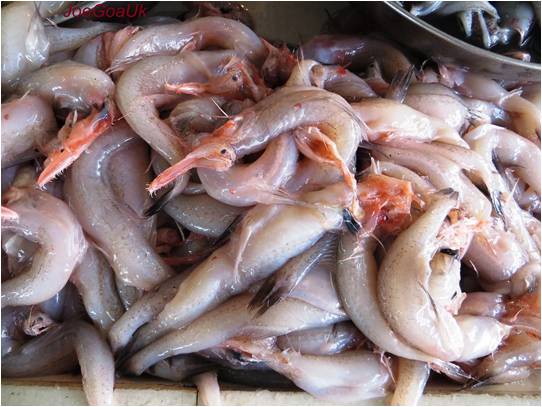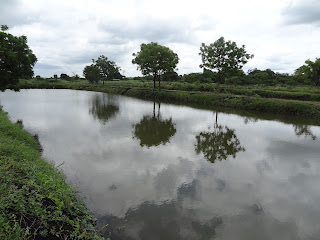Morphometric and Meristic Measurements and Counts Used for the Fishes: In making an account of fish identification, certain terms and abbreviation are used to describe the various parts and measurements of the body of the fish and meristic characters are those characteristics, which can be counted such as scales, fins and fin rays etc. The following terms are of common use, which may be explained as under.
Morphometric and Meristic Measurements
Morphometric Characters:
Total length (T.L.): The entire length of the body of a fish is known as its total length. From the tip of snout with the mouth closed to the tip of the longest ray in the caudal fin
Standard length (S.L.): It differs from that of the total length in that it is measured from the tip of the snout up to the point of origin of the caudal fin i.e. up to the end of the last vertebra of the vertebral column.
Fork length (F.L.): It is the distance from the tip of snout with the mouth closed to the anterior most point of the caudal posterior margin. ‘Morphometric and Meristic Measurements’
Length of head (H.L.): It is a distance, measured from the tip of the snout of the posterior-most point of operculum.
 |
| Lateral view of head |
 |
| Front View of the head |
Length of head excluding the snout (SHL): It begins from the anterior margin of the orbit and extends up to the posterior most bony extremity of the operculum.
Length of Snout (SNL): It is the distance from the tip of the snout up to the anterior margin of the orbit that is said to be the length of the snout.
Postorbital length of the head (POL): It is the distance in a straight line between the posterior margin of the orbit and the posterior most edge of the opercular bone.
Length of caudal peduncle (CPL): It is the distance, which is measured from the posterior base of the anal fin to the origin of the caudal fin. ‘Morphometric and Meristic Measurements’
Height of body (HB): It is measured the vertical distance of the body at its deepest part.
Height of caudal peduncle (CPH): It is measured vertically through the body, at its narrowest part.
Head depth: the vertical distance of the head at its deepest part, measured from the middle at the occiput (the posterior part of the head) vertically downwards to the external contour of the head.
Head width: The distance from side to side at the widest part of the head when the opercules are forced in a reasonably normal position. ‘Morphometric and Meristic Measurements’
Interorbital width: The distance along the dorsal surface of the head lying in between the two orbits is known as interorbital space. ‘Morphometric and Meristic Measurements’
Diameter of the eye (ED): It is measured from one margin of the orbit to the other.
Pre-dorsal length: It is the distance between the anterior most ends of the body and the front end of the dorsal fin base.
 |
| The figure showing a scaly fish of its different fins, scales and measurements. |
Length of upper jaw: From the tip of snout to the posterior edge of the axillary’s bone.
Length of lower jaw: It is the greatest length of lower jaw.
Measurement of fins:
The length of pectoral, pelvic and the caudal fins is measured along their longest fin rays. The height of dorsal and anal fins is measured along their longest rays or spines but the length is measured along their total stretch, beginning from the first fin ray of the spine up to the last fin ray.
Profile of the body: It explains the outline of the body of fish along its dorsal as well as the vertical surfaces.
Barbels: From the anterior base of the barbels to its tip when it is straightened. Barbels are slender and elongated structures which are found around the mouth of many fishes. The number of barbels may very from 1-4 pairs. According to their position, they are named as nasal, rostral, maxillary and mandibular.
Lateral Line (L.I): The lateral line is a longitudinal row of perforations, special sense organs, on the lateral sides of many fishes; it may be complete, incomplete or interrupted. ‘Morphometric and Meristic Measurements‘
Branchiostegeal rays: These are slender bony rods, which are found on the inner surface of the operculum.
Scales: According to the mode of their origin, these are two types of scales. i) Those, which are formed due to the secretary activity of both epidermis and dermis, as the placoid scales of elasmobranch and ii) Non-placoid scales that are derived from the dermis only as the scales of teleost’s. The number of scales along the longitudinal and transverse rows is an important tool in the identification of scaly fishes. If the lateral line is present the scales are counted along its length and their number is written after the abbreviation L.I. In case the lateral line is absent, the scales are counted along the row where the lateral line might have been located and their number is written after the abbreviation L.r. The transverse rows of scales are counted from the anterior base of the dorsal fin in the ventral line and their number is mentioned after the abbreviation L. tr. In this case, if a lateral line is present the scales above and below the lateral line are separated by an oblique (/) stroke; predorsal scales are counted from the extremity to the origin of the dorsal fin. ‘Morphometric and Meristic Measurements’
Meristic Characteristics-Morphometric and Meristic Measurements
The standard abbreviations are used as follows.
ABBREVIATIONS:
A – Anal fin
B – Branchiostegal rays
C – Caudal fin
D – Dorsal fin
O – Adipose fin
P – Pectoral fin
V – Ventral or Pelvic Fin
L.I. – Lateral line of Perforated scales
L.r. – Lateral row of unperforated scales
L.tr. – Lateral transverse rows of scales
FMA – Freshwater of Marathwada region
Examples of some meristic counts are presented below –
FINS AND SCALES FORMULA:
The above abbreviations mentioned are used in the construction of fins and scales formulae of fishes. These formulae provide scientific information to confirm the actual identity of a particular fish. Every abbreviation carries a number or number after it which denotes the number of fin rays, scales etc. Number of fin supports; both types of fin supports; spines, rays for each fin were counted. ‘Morphometric and Meristic Measurements’
Scales count: Scales in the lateral line from the first scale touching the shoulder girdle and terminating at the hypural point. Which a hyphen (-) appear in between the two numerical figures it indicates the range of variation .An oblique (/) stroke and separates two types of range in a single fin such as spiny and unbranched rays from the branched once while a vertical (|) stroke separates different fins from each other, such as the rayed dorsal from the adipose dorsal or the spiny fin from the non spiny one. Thus the fins and scales formula, “D.1/7/0, P.1/8-9, V.6, A. 4/7-9, C. 16 Barbels 4 pairs.” Siluroid fish explained as under figure. IV.
 |
| A Siluroid fish, showing the topography of different fins and other structures |
D (Dorsal Fin) 1/7|0: The dorsal fins are two in number of same fishes 1/7 is separated from second by a vertical stroke .The first dorsal fin possesses as a whole, 8 fin rays out of which the first fin rays are spinous (unbranched) and the 7 fin rays are soft (branched) and hence the above figure pertaining to the same fin are separated by an oblique stroke. ‘Morphometric and Meristic Measurements’
P (Pectoral Fin) 1/8: Whole fin rays 9 out of which the 1st one is spinous and the rest 8 are soft ones.
V (Ventral or pelvic fin) 6: Possesses 6 fin rays of one type only. ‘Morphometric and Meristic Measurements’
A (Anal fin) 4/7-9: Consist of in all 11 to 13-fin rays out of which four are spinous and the rest 7 or 9 are soft ones.
C (Caudal Fin) 17: Has 17 fin rays of one type only ‘Morphometric and Meristic Measurements’
Barbels 4 pairs: The fish possesses 4 pairs of barbels and some fishes of two pairs.
In the above example, the abbreviations L.I., L.r. and L.tr are not met with as in Siluroid fishes the scales are absent. This aspect along with the others can be explained with the help of a formula pertaining to a scaly fish. Thus the following formula can be used-
“D.10 (2/8), P.15-16, V.9, A. 7(2/5), C.19, L.I. 46-48, L.tr.8/9.”
D (Dorsal fin) 10 (2/8): The dorsal fin possesses as a whole, 10 fin rays out of which 2 is spinous and the rest 8 fins are soft. Hence the presence of an oblique stroke in between the two numerical figures
P (Pectoral fin) 15-16: Consist of 15-16 fin rays of one type only.
V (Ventral or pelvic fin) 9: Possesses 9 fin rays of one type only.
A (Anal Fin) 7(2/5): Has total number of fin rays 7 but out of this number two are spinous and rest five (5) are soft. ‘Morphometric and Meristic Measurements’
C (Caudal Fin) 19: Consist of 19 fin rays of one type only.
L.I. (Lateral line of perforated scales): The number of perforated scales are 46-48 along the length of the lateral line varies from 46 to 48. ‘Morphometric and Meristic Measurements’




